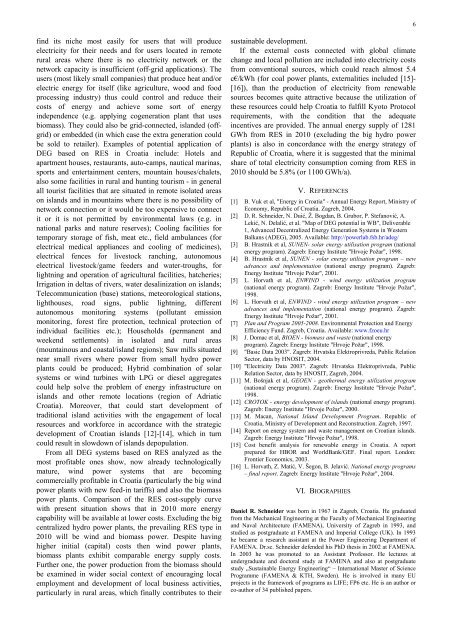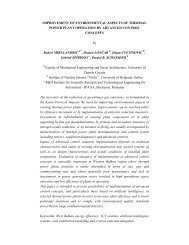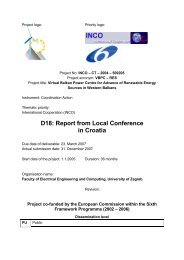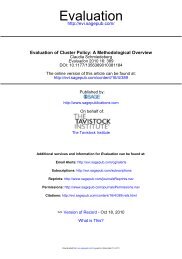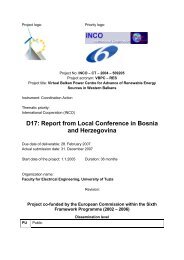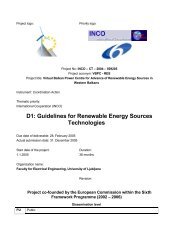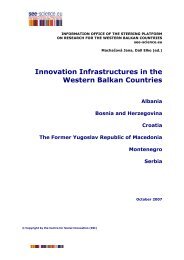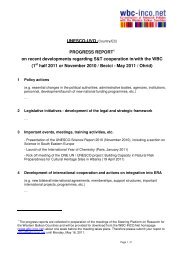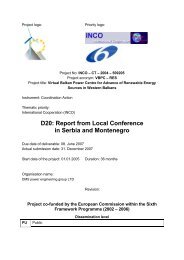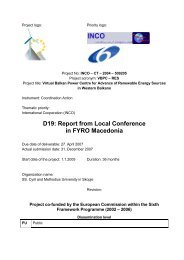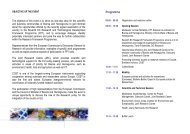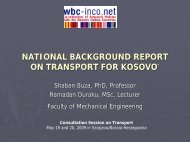Prva stran - WBC-INCO Net
Prva stran - WBC-INCO Net
Prva stran - WBC-INCO Net
You also want an ePaper? Increase the reach of your titles
YUMPU automatically turns print PDFs into web optimized ePapers that Google loves.
find its niche most easily for users that will produce<br />
electricity for their needs and for users located in remote<br />
rural areas where there is no electricity network or the<br />
network capacity is insufficient (off-grid applications). The<br />
users (most likely small companies) that produce heat and/or<br />
electric energy for itself (like agriculture, wood and food<br />
processing industry) thus could control and reduce their<br />
costs of energy and achieve some sort of energy<br />
independence (e.g. applying cogeneration plant that uses<br />
biomass). They could also be grid-connected, islanded (offgrid)<br />
or embedded (in which case the extra generation could<br />
be sold to retailer). Examples of potential application of<br />
DEG based on RES in Croatia include: Hotels and<br />
apartment houses, restaurants, auto-camps, nautical marinas,<br />
sports and entertainment centers, mountain houses/chalets,<br />
also some facilities in rural and hunting tourism - in general<br />
all tourist facilities that are situated in remote isolated areas<br />
on islands and in mountains where there is no possibility of<br />
network connection or it would be too expensive to connect<br />
it or it is not permitted by environmental laws (e.g. in<br />
national parks and nature reserves); Cooling facilities for<br />
temporary storage of fish, meat etc., field ambulances (for<br />
electrical medical appliances and cooling of medicines),<br />
electrical fences for livestock ranching, autonomous<br />
electrical livestock/game feeders and water-troughs, for<br />
lightning and operation of agricultural facilities, hatcheries;<br />
Irrigation in deltas of rivers, water desalinization on islands;<br />
Telecommunication (base) stations, meteorological stations,<br />
lighthouses, road signs, public lightning, different<br />
autonomous monitoring systems (pollutant emission<br />
monitoring, forest fire protection, technical protection of<br />
individual facilities etc.); Households (permanent and<br />
weekend settlements) in isolated and rural areas<br />
(mountainous and coastal/island regions); Saw mills situated<br />
near small rivers where power from small hydro power<br />
plants could be produced; Hybrid combination of solar<br />
systems or wind turbines with LPG or diesel aggregates<br />
could help solve the problem of energy infrastructure on<br />
islands and other remote locations (region of Adriatic<br />
Croatia). Moreover, that could start development of<br />
traditional island activities with the engagement of local<br />
resources and workforce in accordance with the strategic<br />
development of Croatian islands [12]-[14], which in turn<br />
could result in slowdown of islands depopulation.<br />
From all DEG systems based on RES analyzed as the<br />
most profitable ones show, now already technologically<br />
mature, wind power systems that are becoming<br />
commercially profitable in Croatia (particularly the big wind<br />
power plants with new feed-in tariffs) and also the biomass<br />
power plants. Comparison of the RES cost-supply curve<br />
with present situation shows that in 2010 more energy<br />
capability will be available at lower costs. Excluding the big<br />
centralized hydro power plants, the prevailing RES type in<br />
2010 will be wind and biomass power. Despite having<br />
higher initial (capital) costs then wind power plants,<br />
biomass plants exhibit comparable energy supply costs.<br />
Further one, the power production from the biomass should<br />
be examined in wider social context of encouraging local<br />
employment and development of local business activities,<br />
particularly in rural areas, which finally contributes to their<br />
sustainable development.<br />
If the external costs connected with global climate<br />
change and local pollution are included into electricity costs<br />
from conventional sources, which could reach almost 5.4<br />
c€/kWh (for coal power plants, externalities included [15]-<br />
[16]), than the production of electricity from renewable<br />
sources becomes quite attractive because the utilization of<br />
these resources could help Croatia to fulfill Kyoto Protocol<br />
requirements, with the condition that the adequate<br />
incentives are provided. The annual energy supply of 1281<br />
GWh from RES in 2010 (excluding the big hydro power<br />
plants) is also in concordance with the energy strategy of<br />
Republic of Croatia, where it is suggested that the minimal<br />
share of total electricity consumption coming from RES in<br />
2010 should be 5.8% (or 1100 GWh/a).<br />
V. REFERENCES<br />
[1] B. Vuk et al, "Energy in Croatia" - Annual Energy Report, Ministry of<br />
Economy, Republic of Croatia. Zagreb, 2004.<br />
[2] D. R. Schneider, N. Duić, Ž. Bogdan, B. Grubor, P. Stefanović, A.<br />
Lekić, N. Delalić, et al. "Map of DEG potential in WB", Deliverable<br />
1, Advanced Decentralized Energy Generation Systems in Western<br />
Balkans (ADEG), 2005. Available: http://powerlab.fsb.hr/adeg/<br />
[3] B. Hrastnik et al, SUNEN- solar energy utilisation program (national<br />
energy program). Zagreb: Energy Institute "Hrvoje Požar", 1998.<br />
[4] B. Hrastnik et al, SUNEN - solar energy utilisation program – new<br />
advances and implementation (national energy program). Zagreb:<br />
Energy Institute "Hrvoje Požar", 2001.<br />
[5] L. Horvath et al, ENWIND - wind energy utilization program<br />
(national energy program). Zagreb: Energy Institute "Hrvoje Požar",<br />
1998.<br />
[6] L. Horvath et al, ENWIND - wind energy utilization program – new<br />
advances and implementation (national energy program). Zagreb:<br />
Energy Institute "Hrvoje Požar", 2001.<br />
[7] Plan and Program 2005-2008. Environmental Protection and Energy<br />
Efficiency Fund. Zagreb, Croatia. Available: www.fzoeu.hr<br />
[8] J. Domac et al, BIOEN - biomass and waste (national energy<br />
program). Zagreb: Energy Institute "Hrvoje Požar", 1998.<br />
[9] "Basic Data 2003". Zagreb: Hrvatska Elektroprivreda, Public Relation<br />
Sector, data by HNOSIT, 2004.<br />
[10] "Electricity Data 2003". Zagreb: Hrvatska Elektroprivreda, Public<br />
Relation Sector, data by HNOSIT, Zagreb, 2004.<br />
[11] M. Bošnjak et al, GEOEN - geothermal energy utilization program<br />
(national energy program). Zagreb: Energy Institute "Hrvoje Požar",<br />
1998.<br />
[12] CROTOK - energy development of islands (national energy program).<br />
Zagreb: Energy Institute "Hrvoje Požar", 2000.<br />
[13] M. Macan, National Island Development Program. Republic of<br />
Croatia, Ministry of Development and Reconstruction. Zagreb, 1997.<br />
[14] Report on energy system and waste management on Croatian islands.<br />
Zagreb: Energy Institute "Hrvoje Požar", 1998.<br />
[15] Cost benefit analysis for renewable energy in Croatia. A report<br />
prepared for HBOR and WorldBank/GEF. Final report. London:<br />
Frontier Economics, 2003.<br />
[16] L. Horvath, Z. Matić, V. Šegon, B. Jelavić. National energy programs<br />
– final report. Zagreb: Energy Institute "Hrvoje Požar", 2004.<br />
VI. BIOGRAPHIES<br />
Daniel R. Schneider was born in 1967 in Zagreb, Croatia. He graduated<br />
from the Mechanical Engineering at the Faculty of Mechanical Engineering<br />
and Naval Architecture (FAMENA), University of Zagreb in 1993, and<br />
studied as postgraduate at FAMENA and Imperial College (UK). In 1993<br />
he became a research assistant at the Power Engineering Department of<br />
FAMENA. Dr.sc. Schneider defended his PhD thesis in 2002 at FAMENA.<br />
In 2003 he was promoted to an Assistant Professor. He lectures at<br />
undergraduate and doctoral study at FAMENA and also at postgraduate<br />
study „Sustainable Energy Engineering“ – International Master of Science<br />
Programme (FAMENA & KTH, Sweden). He is involved in many EU<br />
projects in the framework of programs as LIFE; FP6 etc. He is an author or<br />
co-author of 34 published papers.<br />
6


